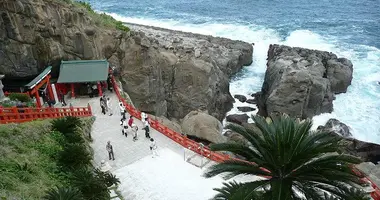Terukuni Shrine Kagoshima
Terukuni Shrine, Kagoshima City 照国神社
The most important shrine in Kagoshima city is the Terukuni Shrine, easily found by the giant white torii in the downtown area.
As shrines go it is not very old, being founded in 1864. Terukuni Shrine was rebuilt after being damaged in the final battle of the Satsuma Rebellion, "Saigo's Last Stand", but the current structures date from the post World War II reconstruction following air raid damage.
Perhaps the most distinctive feature of the shrine is the huge tree pruned into the shape of a bird with outstretched wings. The reason for the shrine being so modern is that the kami enshrined here was the 28th Lord of Satsuma, Shimazu Nariakira, and he lived until 1858.

Terukuni Shrine torii, Kagoshima City, Kyushu

Terukuni Shrine, Kagoshima, Kyushu
There are many ceremonies and festivals held at Terukuni Shrine throughout the year. For the first few days of the new year the shrine will be packed with residents making their Hatsumode, the first shrine visit of the year, and the Setsubun Festival on February 3rd is also very popular.
In the middle of July Kagoshima holds its Lantern Festival, Rokugatsu-do, and the shrine will be lit by thousand of lanterns and the stalls spill out from the shrine grounds into the streets. For pomp and ceremony the main event at the shrine is held on the anniversary of Nariakira's birth on October 28th.
Terukuni Shrine is open every day from 8.30pm to 5pm
19-35 Terukuni-cho, Kagoshima 893 0841
Tel: 099 222 1820
Terukuni Shrine is located close to the Kagoshima City Art Museum and Tanshoen Garden and 20 minutes on foot from Kagoshima Chuo Station or five minutes from Tenmonkan bus or tram stop.
Shimazu Nariakira
Shimazu Nariakira was born in Edo (present-day Tokyo) in 1809 and like the children of other daimyo (feudal lords) was raised in that city rather than in his home domain of Satsuma.
Following succession struggles within his family, which would not be out of place in a Shakespeare play, he was made Daimyo of Satsuma in 1851 when the Shogunate forced his father to retire. Though he only reigned 7 years until his death in 1858 he had a major impact upon Satsuma and Japan.
From his grandfather he inherited a love and fascination with things Western, and set about modernizing his military with western tactics, training, and weaponry. He built the first western-style warship, the Shohei Maru, from Dutch plans in 1854.
He established the Shuseikan, a factory for producing primarily cannons, located next to the grounds of the Sengan-en Garden, and used Morse code for the first time in Japan sending a message from the park next to the Terukuni Shrine to the main keep of the castle 600 meters away.
It is believed he designed the flag that became the first national flag of Japan, and he got hold of the first daguerreotype camera in Japan. A photo of Nariaraki taken by a retainer was the original object of worship at the Terukuni Shrine but then disappeared. It was later rediscovered in a warehouse and is now acknowledged as being the oldest extant photo by a Japanese.
His support of Saigo Takamori was influential in the latter's rise to power in Satsuma domain and subsequently the national government. Following Nariaraki's death his successors continued and expanded his program of modernization.
Hotels In Kagoshima
The area around Kagoshima Chuo Station has many hotels including the Hotel Gastof, the Hotel Urbic Kagoshima, the Toyoko Inn Kagoshima Chuo-eki Nishi-guchi, the JR Kyushu Hotel Kagoshima Hotel and the APA Hotel Kagoshima Chuo-Ekimae.

Terukuni Shrine, Kagoshima, Kyushu

Nariaraki Statue, Terukuni Shrine, Kagoshima, Kyushu
Book Hotel Accommodation in Kagoshima Japan
Guide Books on Japan
Terukuni Shrine is the most important shrine in Kagoshima which enshrines the 28th feudal lord of Satsuma and reformer, Shimazu Nariakira.












